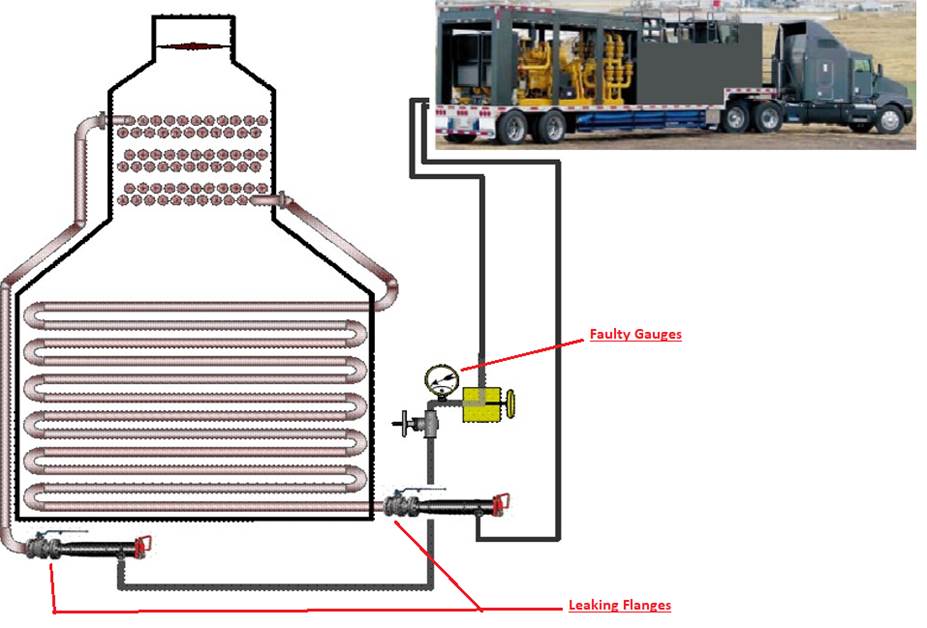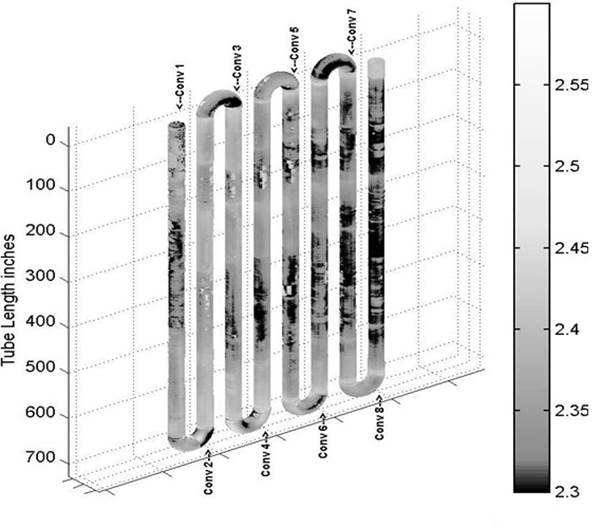Best Practices and Pitfalls for Decoking & Inspection in Delayed Coker Heaters
Serpentine coils in Delayed Coker Heaters are challenging to clean and inspect even while utilizing today’s latest technologies. Extensive fouling on the coils interior surface often warrants cleaning intervals of two years, or less, depending on online spalling capabilities.
 Mechanical decoking pigs are now commonly utilized to clean fouling (aka decoking), from the heater coils interior however there’s a wide variation of cleaning pig designs on the market and associated effectiveness of each. Pump truck equipment operator experience, combined with supporting equipment such as pumps, valve systems, launcher/receivers, etc. play a significant role in the overall success of each cleaning effort. An experienced pump operator on the mechanical decoking team is essential in assuring appropriate equipment selection (ie. mechanical cleaning pig design type, appendage material hardness/shape selection, pump flow rates during cleaning, pig flow resistance monitoring, etc. The approach used to remove soft coke verses hard coke requires different operational approaches to ensure removal of fouling without inadvertent removal of parent tube material. In addition to pump truck operating experience, ensuring proper functioning equipment is critical. Not only is it a potential safety concern, worn out or faulty equipment (ie. leaking valve flanges/gaskets, loose hose connections, malfunctioning pressure gauges, etc.) can result in discharge of water combined with hydrocarbons at the work area, in addition to an ingress of unwelcome amount of air being sucked back into the coil during cleaning. It’s also critical for the equipment owner/operator to be engaged with the decoking contractor to supply history of the equipment and key QA/QC checks to achieve through the event to ensure a successful decoke and inspection.
Mechanical decoking pigs are now commonly utilized to clean fouling (aka decoking), from the heater coils interior however there’s a wide variation of cleaning pig designs on the market and associated effectiveness of each. Pump truck equipment operator experience, combined with supporting equipment such as pumps, valve systems, launcher/receivers, etc. play a significant role in the overall success of each cleaning effort. An experienced pump operator on the mechanical decoking team is essential in assuring appropriate equipment selection (ie. mechanical cleaning pig design type, appendage material hardness/shape selection, pump flow rates during cleaning, pig flow resistance monitoring, etc. The approach used to remove soft coke verses hard coke requires different operational approaches to ensure removal of fouling without inadvertent removal of parent tube material. In addition to pump truck operating experience, ensuring proper functioning equipment is critical. Not only is it a potential safety concern, worn out or faulty equipment (ie. leaking valve flanges/gaskets, loose hose connections, malfunctioning pressure gauges, etc.) can result in discharge of water combined with hydrocarbons at the work area, in addition to an ingress of unwelcome amount of air being sucked back into the coil during cleaning. It’s also critical for the equipment owner/operator to be engaged with the decoking contractor to supply history of the equipment and key QA/QC checks to achieve through the event to ensure a successful decoke and inspection.

Often refiners will choose to utilize ultrasonic (UT) based Intelligent Pigging technology directly after cleaning of the heater coils to: (1) Verify Coil Cleanliness (SEE IMAGE), (2) Detect/Quantify damage mechanisms and (3) Establish current coil condition to enable fitness for service and remaining life expectancy. The latest available UT intelligent pigging technology simultaneously maps both the “interior surface” and “pipe wall remaining thickness” as the instrument traverses through the heater serpentine coil. High resolution dimensional maps generated of the coils interior surface can be used in creating 2-dimensional (2D) and 3-dimensional (3D) images illustrating presence of internal fouling (ie. coke, scale, etc.) and quantify volume of fouling. Simultaneously ultrasonic test data collected on the pipes exterior surface can be used to generate high resolution 2D/3D images illustrating remaining pipe wall thickness, as well as deformation such as bulging, swelling or ovality. Because damage mechanisms may be dimensionally small or isolated (ie. pitting, corrosion, fretting, etc.) selecting intelligent pig technology which provides overlapping coverage, capturing 100% surface inspection is essential. Otherwise small, isolated areas of localized wall loss may not be captured due to less than full inspection coverage. Areas missed during the inspection which contain unacceptable minimal remaining thickness will not only impact the ability to make immediate repairs, it will also impact future heater coil life predictions, corrosion rate calculations, etc. Areas of UT data loss can also lead to unnecessary equipment constraints due to the assumption of residual fouling which may not actually be present.
Often the mechanical decoking equipment (ie. pumps, launcher/receiver, valves, hoses, etc.) will remain attached to the heater coil after the mechanical decoking cleaning effort is completed and used to deploy and propel the intelligent pigging instrument. As mentioned earlier, air inadvertently sucked into coil due to faulty equipment can result in poor quality, or no inspection results. Because the ultrasonic (UT) method requires a solid liquid coupling between the instrument and pipe surface any presence of air will prohibit the high frequency UT sensors from functioning, therefore these areas within the coil will not be inspected. This can be a small area (i.e. air bubbles) or large area (ie. large air pockets) depending on the severity of the air ingress. Air will naturally rise to the upper sections of vertically orientated sections or the top dead center of horizontally orientated serpentine coils. Sections of the heater coil containing air will result in an area left without inspection data.
Both Mechanical Decoking Pigging and Intelligent Inspection Pigging processes depend heavily upon one another to ensure the success of each intended task. Proactive planning in advance of upcoming plant turnarounds can assist greatly in proper contractor/technology selection to ensure quality of outcome. Developing procedures which set strict guidelines in terms of technology selection and operational protocols are essential.
In the event the heater coils are not adequately cleaned, air is allowed into the system and insufficient inspection coverage is not achieved the following sacrifices may result:
- Coke/Scale left in heater coil after decoking:
- Localized coil overheating once heater is brought back online,
- Coil may coke up faster at fouled locations once back online,
- Intelligent Pigging inspection data quality may be compromised or completely lost within areas of remaining interior fouling.
- NOTE: Intelligent pigging data results can be used to Quality Control (Q/C) cleaning effort and direct additional cleaning to specific areas if necessary.
- Air Ingress during Mechanical Decoking:
- Intelligent Pigging inspection data quality compromised or completely lost in these areas will occur.
- Compromised Inspection Results:
- Minimum remaining pipe wall thickness may be missed, resulting in compromised corrosion rate calculations.
- Most severe areas of strain (swelling, bulging) may not be measured accurately resulting in over or under conservative Fitness For Service (FFS) and Remaining Life Assessment (RLA) calculations.
In conclusion, preplanning heater coil decoking and inspection well in advance of a turnaround is essential in ensuring higher quality cleaning and integrity of the inspection outcome. Becht’s staff have decades of experience developing formal written procedures, key QA/QC criteria to guide field decisions and partnering directly with refinery personnel and decoking contractors to highlight key components necessary to be monitored during both mechanical decoking and intelligent pigging.
